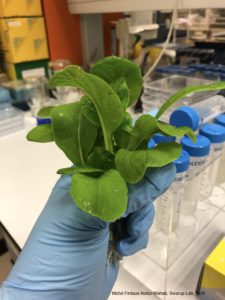Food security is a very important issue nowadays. It is an already complex issue made worse by climate change, and the growing scarcity of arable land due to rapid urbanisation. The UN has reported that “815 million people are hungry today, and the additional 2 billion people expected to be undernourished by 2050”. Goal 2 (Zero Hunger) of the UN Sustainable Development Goals (SDG) calls for an increased investment in agricultural research to increase the agricultural productive capacity, particularly in developing countries.
Genetic engineering of food crops has the potential to provide the promising solutions, by providing the technology to develop higher yield, drought resistance, and nutritionally-enhanced food crops. However, the public perception of genetically-modified organisms (GMO) and transgenic plants has hampered the acceptance of many GM products.
Advancements in microbiology and microbial ecology has shed light on the importance of plant-associated microorganisms, particularly the community around the root region (rhizosphere). It is now known that there is a complex network of interactions between plants and their root microbes, increasing the plant nutrient uptake, and provide resistance to biotic and abiotic stresses. The rhizosphere is populated by a diverse range of microorganisms, and rhizobacteria are the bacteria colonizing this habitat with the ones that promote plant growth are called plant growth-promoting rhizobacteria (PGPR) (Beneduzi et al., 2012). These PGPR can be used to enhance agricultural productivity without using plant genetic modifications, or synthetic fertilisers. But understanding these PGPR and how they interact with their plant hosts requires the latest technologies in microbial ecology, molecular biology, plant sciences and chemical analysis.
I joined the Swarup Lab at the National University of Singapore (NUS) in January 2019, as part of my post-doctoral training, to learn more about these latest technologies. My work here involves the use of multi-omics analysis (metagenomics, metatranscriptomics and metabolomics) to study plant-microbial interactions, particularly how the PGPR at the root region affect the growth of green leafy vegetables. Multi-omics analysis uses information obtained from DNA, RNA and small chemical molecules (known as metabolites) found in the plant rhizosphere. I will also use advanced culturing tools to culture and characterise the complex bacterial communities in the rhizosphere. Bacteria found to have beneficial plant improvements traits can be applied to enhance the yield of agricultural products, in this case the leafy vegetables commonly used in urban farming. This microbial-assisted plant growth enhancement technology can lead to a more sustainable agriculture, lowering the use of chemical fertilisers, pesticides and herbicides.
References:
UN Sustainable Development Goals (https://www.un.org/sustainabledevelopment/sustainable-development-goals/)
Beneduzi et al., 2012. Plant growth-promoting rhizobacteria (PGPR): Their potential as antagonists and biocontrol agents. Genet Mol Biol. 35(4 Suppl): 1044-1051.


